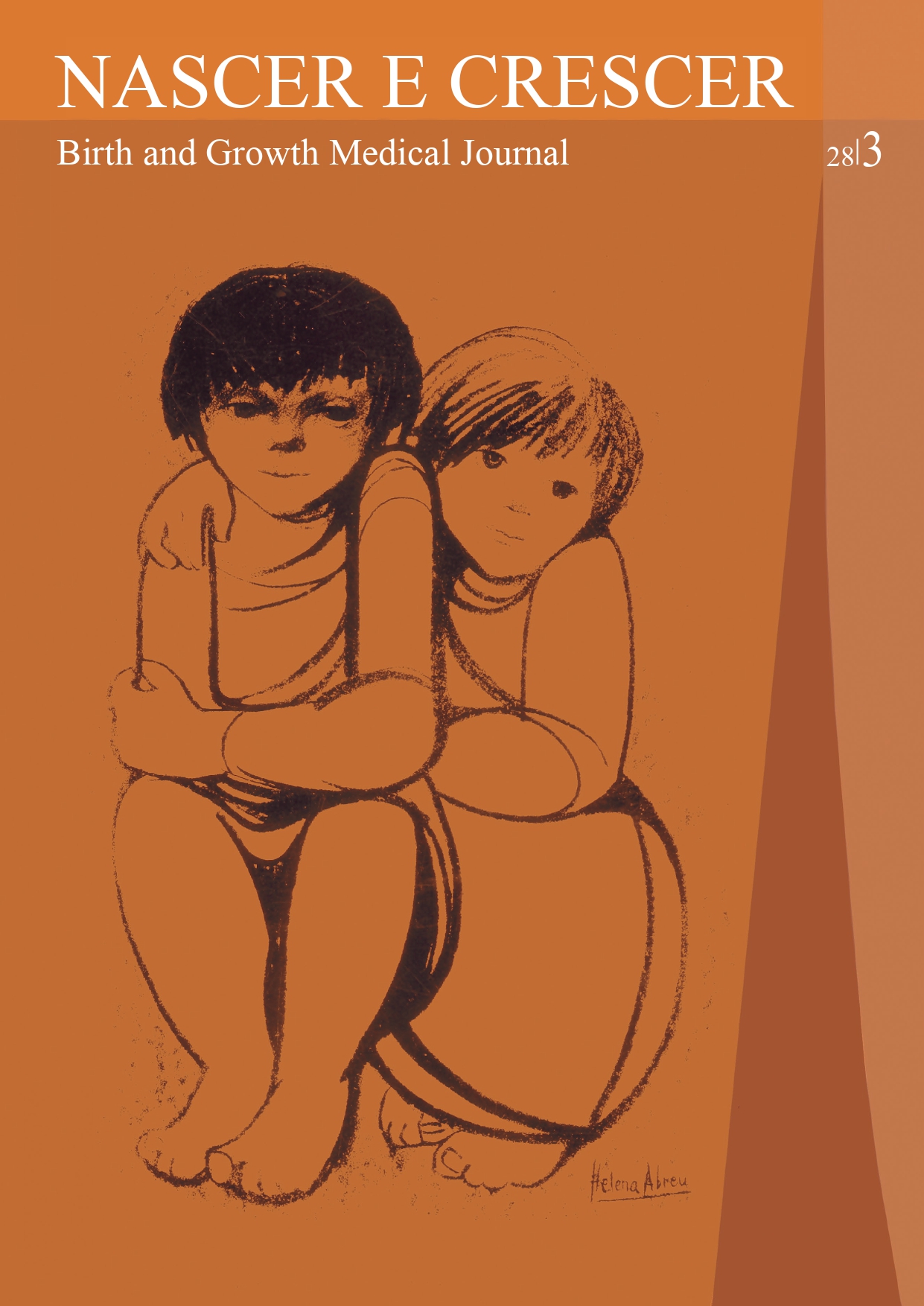Síndrome pólen-frutos na adolescência
DOI:
https://doi.org/10.25753/BirthGrowthMJ.v28.i3.15730Palavras-chave:
alergia, síndrome-pólen-frutos, profilinaResumo
O síndrome pólen-frutos (SPF) caracteriza-se por sintomas alérgicos causados pela ingestão de frutas ou vegetais crus em doentes com rinite/ rinoconjuntivite alérgica sazonal. A prevalência estimada de SPF em doentes com polinose é de 50−70%. Tipicamente, o SPF manifesta-se através de sintomas alérgicos localizados na cavidade oral (síndrome de alergia oral − SAO). Os autores descrevem o caso de uma adolescente com rinite alérgica a gramíneas, submetida a imunoterapia oral durante quatro anos e quatro meses, que desenvolveu SAO a frutos frescos e nozes. Os exames complementares de diagnóstico revelaram sensibilização a vários alergénios, particularmente a profilina, aparentemente responsável pelo SPF. A doente permanece assintomática com evicção de todos os frutos frescos e nozes, atualmente tolerando maçã cozinhada, sem sintomas.
Downloads
Referências
2. Mastrorilli C, Tripodi S, Caffarelli C, Perna S, Di Rienzo-Businco A, Sfika I, et al. Endotypes of pollen-food syndrome in children with seasonal allergic rhinoconjunctivitis: a molecular classification. Allergy: European Journal of Allergy and Clinical Immunology. 2016; 71:1181-91.
3. Ta V, Scott D, Chin W, Wineinger N, Kelso J, White A. Differential skin test reactivity to pollens in pollen food allergy syndrome versus allergic rhinitis. Allergy and Asthma Proceedings. 2015; 36: 379–85.
4. Rodríguez del Río P, Díaz-Perales A, Sánchez-García S, Escudero C, Ibáñez MD, Méndez-Brea P, et al. Profilin, a Change in the Paradigm. J Investig Allergol Clin Immunol. 2018; 28:1-12.
5. Hauser M, Egger M, Wallner M, Wopfner N, Schmidt G, Ferreira F. Molecular properties of plant food allergens: a current classification into protein families. The Open Immunology Journal. 2008; 1: 1-12.
6. Nunez R, Carballada F, Lombardero M, Jimeno L, Boquete M. Profilin as a aeroallergen by means of conjunctival allergen challenge with purified date palm profilin. Int Arch Allergy Immunol. 2012; 158:115-9.
7. Ruiz-Garcia M, Garcia del Potro M, Fernandez-Nieto M, Barber D, Jimeno Nogales L, Sastre J. Profilin: a relevant aeroallergen? J Allergy Clin Immunol. 2011; 128:416–8.
8. Santos A, Van Ree R. Profilins: mimickers of allergy or relevant allergens? Int Arch Allergy Immunol. 2011; 155:191-204.
9. Scheurer S, Lauer I, Foetisch K, San Miguel Moncin M, Retzek M, Hartz C, et al. Strong allergenicity of Pru av 3, the lipid transfer protein from cherry, is related to high stability against thermal processing and digestion. J Allergy Clin Immunol. 2004; 114:900–7.
10. Asero R, Tripodi S, Dondi A, Di Rienzo Businco A, Sfika I, Bianchi A, et al. Prevalence and Clinical Relevance of IgE Sensitization to Profilin in Childhood: A Multicenter Study. International Archives of Allergy and Immunology. 2015; 168:25-31.
11. Brozek J, Bousquet J, Agache I, Agarwal A, Bachert C, Bosnic-Anticevich S, et al. Allergic Rhinitis and its Impact on Asthma (ARIA) guidelines-2016 revision. Journal of Allergy and Clinical Immunology. 2017; 140:950-8.
12. Villalta D, Conte M, Asero R, Da Re M, Stella S, Martelli P. Isolated IgE reactivity to native walnut vicilin-like protein (nJug r 2) on ISAC™ microarray is due to cross-reactive carbohydrate epitopes. Clin Chem Lab Med. 2013; 51:1991-5.
13. Ebo DG, Hagendorens M, De Knop KJ, Verweij M, Bridts CH, De Clerck LS, et al. Component-resolved diagnosis from latex allergy by microarray. Clin Exp Allergy. 2010; 40: 348-58.
14. Nilsson C, Brostedt P, Hidman J, van Odijk J, Borres P, Sjölander S, et al. Recognition pattern of kiwi seed storage proteins in kiwifruit-allergic children. Pediatric Allergy and Immunology. 2015; 26:817–20.
15. Bublin M, Radauer C, Knulst A, Wagner S, Scheiner O, Mackie AR, et al. Effects of gastrointestinal digestion and heating on the allergenicity of the kiwi allergens Act d 1, actinidin, and Act d 2, a thaumatin-like protein. Mol Nutr Food Res. 2008; 52:1130-9.
Downloads
Publicado
Como Citar
Edição
Secção
Licença
Copyright e Direitos dos Autores
Todos os artigos publicados na Revista Nascer e Crescer – Birth and Growth Medical Journal são de acesso aberto e cumprem os requisitos das agências de financiamento ou instituições académicas. Relativamente à utilização por terceiros a Nascer e Crescer – Birth and Growth Medical Journal rege-se pelos termos da licença Creative Commons "Atribuição - Uso Não-Comercial - (CC-BY-NC)"".
É da responsabilidade do autor obter permissão para reproduzir figuras, tabelas, etc. de outras publicações.
Juntamente com a submissão do artigo, os autores devem enviar a Declaração de conflito de interesses e formulário de autoria. Será enviado um e-mail ao autor correspondente, confirmando a receção do manuscrito.
Os autores ficam autorizados a disponibilizar os seus artigos em repositórios das suas instituições de origem, desde que mencionem sempre onde foram publicados e de acordo com a licença Creative Commons.


